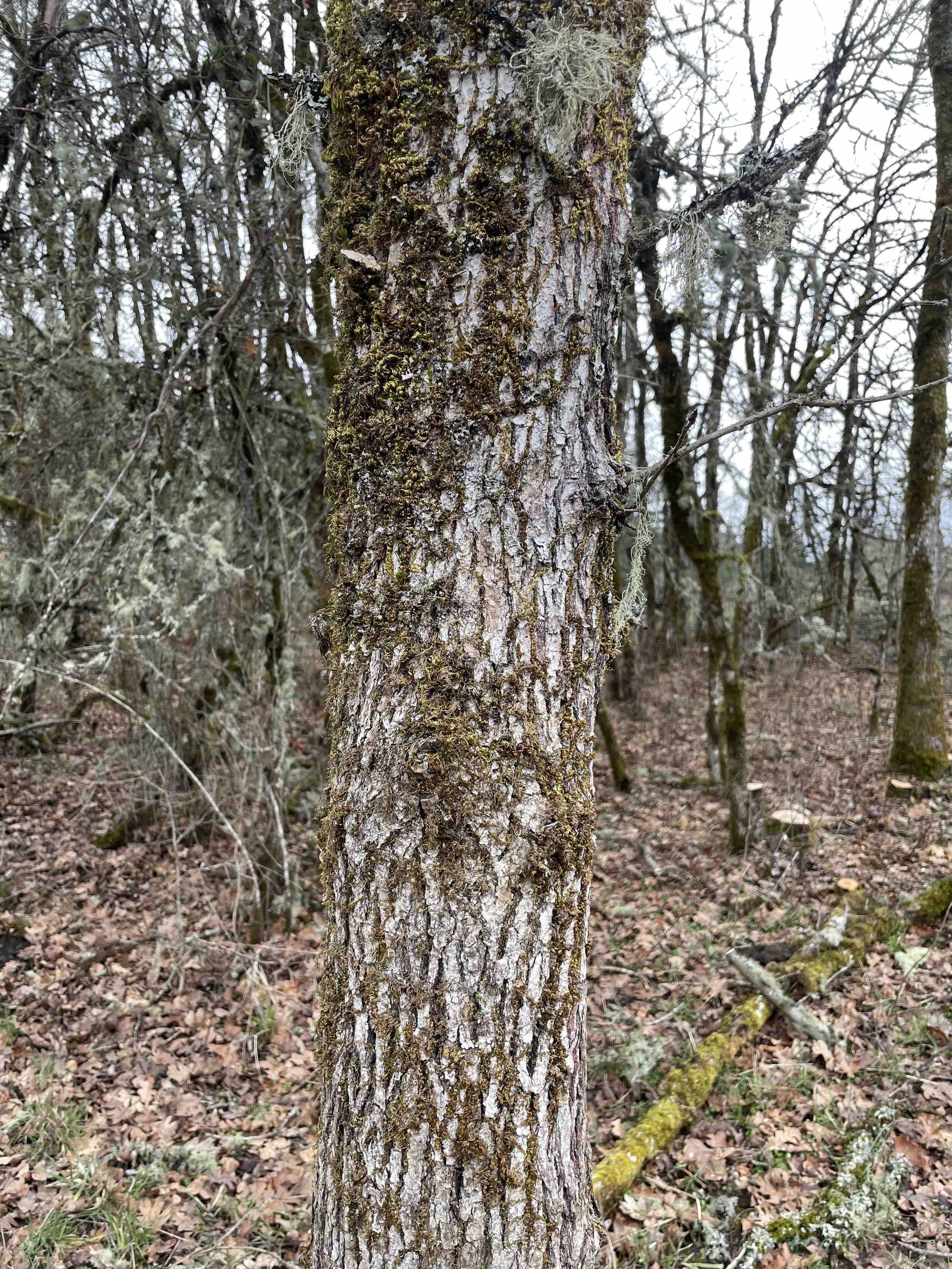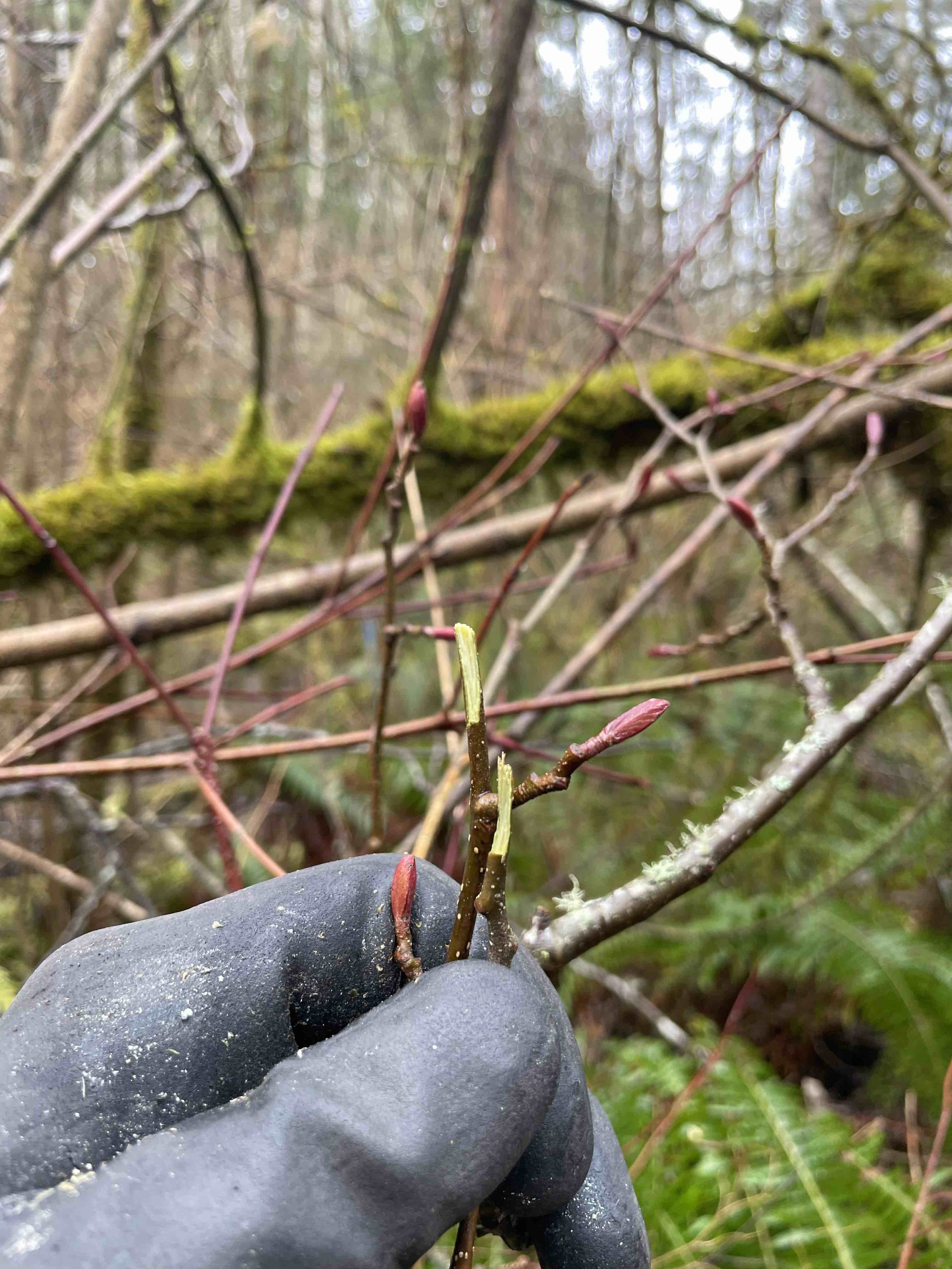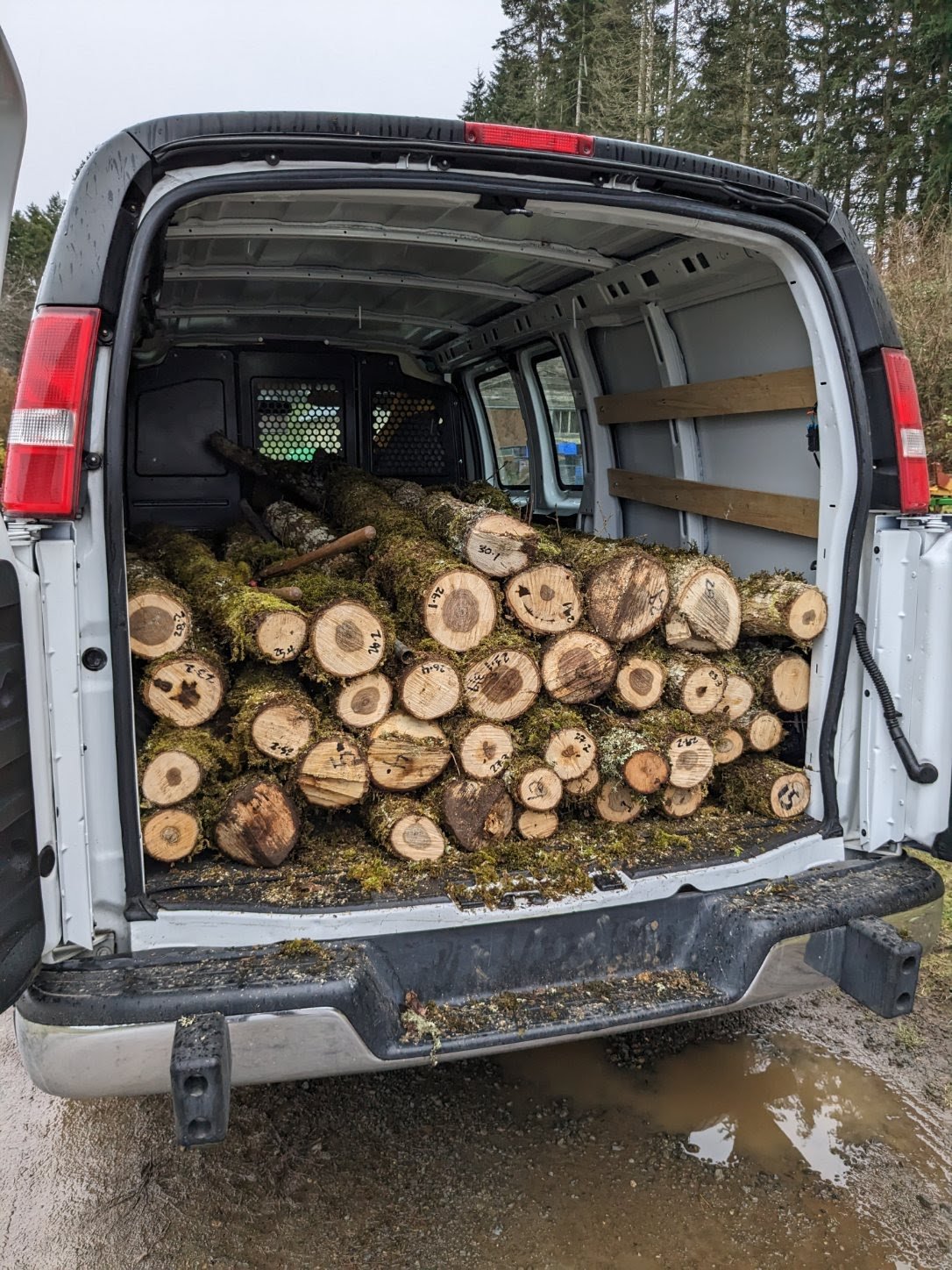Timber
Timber is the substrate (food) and growing medium for forest-cultivated mushrooms, and the foundation of these production systems. Different species of timber affect the productivity of mushrooms in dynamic ways. Similar to the soil of a farm field, your timber should match the needs of the crop and be attended to accordingly in order to reliably produce quality mushrooms.

Tree species selection & determining timber volumes needed:
Logs used in shiitake production (“bolts”) must be sourced from timber that has been recently cut (2-6 weeks prior) from a living broadleaf tree species. Not all species of broadleaf tree have been tested in the PNW for their suitability to shiitake production, but the most accessible and reliably productive species for shiitake tested so far are red alder (Alnus rubra) and garry oak (Quercus garryana). One other common native species, bigleaf maple (Acer marophyllum) has been tested but has shown to be unreliable for shiitake production. Three other non-native species found in the PNW have also been tested for shiitake production: gray birch (Betula populifolia, similar to native paper birch, B. papyifera), common hazelnut (Corylus avellana), and sweet cherry (Prunus avium); gray birch and hazelnut have produced shiitake well in trials. Sweet cherry produces reliably also, but has generally produced a lower yield overall in trials compared to the other suitable species tested so far. Other native PNW species that may be suitable based on preliminary observations are paper birch (B. papyifera) and scouler’s willow (Salix scoulariana). For mushroom bolts, you will be targeting trees that are 5-6.5” in diameter (16-20.5” around) when measured ~6-12” from the base of the tree. See the “Timber identification and species selection tips” page for more detailed information on tree species:
LINK: Timber identification and species selection tips
You’ll need to determine first the volume of timber you’ll need for your the number of mushroom bolts you’re wanting to put into production. As a reference point, you may be able to average 4-6 bolts from a garry oak tree, and 5-10 bolts from an alder tree. So each 100 bolts-worth may will require felling 17-25 small garry oak trees, or 10-20 small alder trees. In reasonably dense stands of both of these tree species, this amount could be thinnings from ~1/2 acre of forest or less. If you need to negotiate with a private landowner, they may more easily be able to visualize timber volume in terms of firewood cords (4x4x8’ split and stacked); the amount of timber required for 100 mushroom bolts (logs) is approximately equivalent to 0.54 cords of wood. Timber used for mushroom bolts should be in good condition with intact bark. Generally refrain from using any timber that has been felled or blown down more than ~6-8 weeks prior to inoculating, or timber with significant bark or splitting damage.
Timber sourcing:
If you don’t have timber on-site, ideas for finding sources of timber locally are classified ads, social media groups, timber companies, arborists, and organizations that may have email networks with private forest owners. If you need to negotiate with a private landowner, be very explicit about the size ans species of log you’re needing, and that the bark needs to be intact and in good shape if the landowner wants to do the cutting for you (sometimes due to liability concerns). Sometimes landowners can get a notion that mushroom bolt timber may be lucrative for them, but it’s important to remember that often the size of tree needed is often the size that may often be thinned anyway from a crowded stand, and mushroom profit margins may not be very forgiving to timber sold at a premium. Prices are not firm for shiitake bolt timber, and often landowners may be glad to just have trees thinned from their property for free. Cornell University (Gabriel) gives these as general ballpark prices for bolts (in the northeastern US, this would most typically be oak or hard maple):
$.50/bolt for salvage work where a buyer does all the work on site
$1.00/bolt harvested by the seller and picked up at harvest site by the buyer
$2.00 – 3.00/bolt with the seller harvesting and delivering to the buyer
If you’re struggling to find a nearby source of timber for your bolts, you can see about applying for a Special Forest Products permit on public lands; mushroom logs are not a listed use, but “posts” and “rails” commonly are. Rules vary widely, so you will need to call your respective ranger district office to find out what mushroom bolts would be classified as, and how much they may cost. In Washington state, the Department of Natural Resources (DNR) may be willing to issue Direct Sale contracts for small timber harvests. You will need to find an accessible DNR parcel of interest, and directly contact WA DNR directly to find out who the unit forester is in order to negotiate the contract. As long as the parcel of interest is available, the forester will request to meet with you at the site to determine a price and discuss the terms of the contract. A Map of WA DNR Lands can be found here: https://www.dnr.wa.gov/publications/eng_rms_trustlands_map_nu2.pdf. Private timber companies with large land holdings (such as Weyerhaeuser) often have special forest products permits also, but they tend to be more expensive and limited (~$300).
On-site timber selection:
Unless you pre-scout for trees in late spring/summer/early fall, you will often be looking for trees in winter. So you’ll need to know what your target species look like without the leaves to clue you in (Figure 1). Often you may not be able to examine tree buds even because branches are often too high up on the tree, so you will need other clues from to help differntiate species. Commonly, Oregon ash, bigleaf maple, and garry oak may look similar; Pacific dogwood can look like red alder; sweet cherry and bitter cherry look nearly identical, etc. Again refer to the (LINK:) “Timber identification and species selection tips” page for guidance on tree species and identification in winter.
The straighter the tree is, the more efficient your bolts will be in the long run within your production system. Pioneer species of trees such as alder and birch will often grow in dense stands that provoke trees to grow straight and tall. Look for trees that maintain their girth well throughout the trunk, rather than ones that taper down quickly. Also watch out for trees that may be dead or diseased. This can be hard to determine in winter, but if there are any low branches within reach, break some small twigs near the end of the branch and look for green color just under the surface of the bark, along with whther the buds appear to be soft and living (Figure 2). If a tree has been diseased, you can often see dark staining in the sapwood once the tree is cut. Sometimes competing white-rot fungi will also come in through a dead branch stub, or an old injury to the trunk. So far in the PNW, shiitake appears to be a very competive fungus, and issues with competing fingi have not been overt often except for a few isolated instances where a dead branch from a Hazelnut (Corylus avellana) tree and an injured spot on a Scouler’s willow (Salix scoulariana) were pre-infected with a Trametes bracket fungus that continued to spread after inoculation with shiitake.
Timing timber felling and bolt-cutting:
Timber-felling for shiitake bolts should happen before trees break their dormancy in spring (i.e. before bud break). During dormancy, the tree’s cell walls are hardened off, and the tree more readily retains its bark. Some shiitake growers fell their timber anytime after the leaves have dropped in autumn, but most target late winter for timber-felling followed by inoculation with shiitake several weeks later in early spring. In the Pacific Northwest, tree dormancy generally can begin breaking by early to mid-March depending on a given year’s temperature patterns. The budding of indian plum (Oemleria cerasiformis), is an obvious visual bellwether that your trees are likely on the precipice of breaking their dormancy. If your felling needs to go beyond early March, you can try to source trees from north facing slopes, or trees that are otherwise well-shaded from southern sun exposure that would otherwise incite earlier bud-break.
Although trees used in shiitake production are relatively small, tree-felling is inherently dangerous. Be sure to use proper safety equipment, and learn proper safety precautions from a trustworthy information source before felling trees and operating a chainsaw. Timber may often fall in unanticipated ways; be familiar how to avoid common pitfalls like “barber-chairing” and saw blade pinching, and get familiar with different tree felling techniques. Even if you have previous experience, push yourself to read or watch a safety refresher to make sure you all your points are covered, current, and fresh in mind, and that you’ve not become too lax on your safety measures over time. Avoid felling trees alone, and make sure you are communicating very clearly about safety with whomever you are felling with.
Some of you trees will inevitably end up getting hung up on other trees after felling. Make sure all trees are on the ground by the time you leave so that they’re not a safety hazard. Often you may be able to work smaller trees out of a snag by hand, but you can also bring a come-along winch and/or large ratchet strap with you to make sure you can pull your trees down out of the canopy. Having a sturdy metal bar, large rubber mallet, bow saw, loppers, and/or hatchet with you can also help. Bringing along a 50’ tape measure with you can be useful in helping you to take an inventory of how many bolts you’ll be able to get from each tree. A 5’ sewing tape measure is also useful to keep in your pocket to gauge tree diameter and/or inventory your bolts. Your smallest bolt should no less than 4” in diameter (~12.5” circumference) and no more greater 6.5” (~20.5” circumference) on the larger end of the bolt. Logs are usually 4’ lengths for bolts; this is a size (and weight) that is reasonable to handle. You can mark the bark on the tree every 4’ with a large permanent marker so that it’s easy to see where to cut your bolts. Keeping your logs to a relatively uniform length will help streamline production in the long run.
You do not need to immediately buck your logs into bolts at the time of felling. You can leave your logs in-tact, on the ground for several weeks and then return to cut them into bolts when you’re ready to transport them off-site. This is because shiitake is not able to immediately begin consuming the wood. It benefits from having a period where the tree can die back. Felling your trees a month in advance of when you plan to inoculate is a reasonable target. Waiting to buck your trees up into bolts until right before inoculating is also favorable for log moisture retention and keeping other fungi out. Note that it very easy to forget or lose track of where your cut trees are in the forest, so having a method to mark their locations is very helpful. Bright-colored marking tape is an affordable easy option for this, and if make sure it’s not a color that’s easy for you to see amongst other forest colors, such as bright pink or blue.
When cutting your logs into bolts, be very mindful to avoid damage to the bark. Limbing can be done at felling, or just before bolt-cutting. Using a chainsaw for limbing is often inefficient and it is difficult to avoid damaging to the bark in the process. Long-handled loppers are more efficient and avoid risk of damage to the bark. Cut close limbs close to the bark as you can, as limb nubs will become a nusance later on as the bolts move through different parts of the shiitake production system.
Moving and transporting timber:
Wherever you end up getting your timber from, make sure you have decent access to get it transported to your site (Figure 3). Also consider that you’re often cutting and retrieving logs during the more rainy parts of the year in the PNW, which may further restrict access . Always lift logs/bolts with your legs, not your back. Stick to carrying one bolt at a time. Balancing two heavy, fresh bolts while walking through a slippery forest full of tripping hazards gets unwieldy. As a reference, 4’-long, 5”-diameter fresh red alder bolts weigh approximately ~25.5lbs, whereas fresh garry oak bolts average ~31.5lbs per bolt. Logs should always be covered during transport at highway speeds unless it’s a rainy day, and/or you are just moving them at slow speeds (such as in a tractor wagon). Unprotected, fresh-cut logs exposed to rapid drying conditions at highway speeds during transport will readily crack on the end of the log, which can additionally lead to bark rupture; both will compromise the long-term integrity of the log. Provided you have decent road access for a 2-wheel drive vehicle to where you felled your timber, moving logs with a box van is a favorable option because they can handle a considerable amount of cargo and also easily protect from logs/bolts wind during transport (Figure 4).

Figure 1. Trees can be notoriously difficult to identify in winter. Based on the bark alone, this garry oak could easily be mistaken for Oregon ash or bigleaf maple.

Figure 2. Your timber must be living when it's cut. In winter, it is often difficult to tell if a standing tree might already be dead. If there is any question, break some small twigs on the tree to look for green color under the bark and for buds that appear to be alive, such as in this picture of red alder.

Figure 3. Be sure to your logs cut in an accessible location. If you need to transport your logs in a vehicle, that means close to a decent road. Having a helper to move your logs from the forest to a good road access point can be a major help, as the effort of moving logs any distance by hand can add up very quickly.

Figure 4. A box van can be a very useful option to transport logs/bolts from one site to another. They can accommodate a tall, heavy cargo load, keep your equipment out of the rain, and, importantly, eliminate the need for tarping to protect logs from drying during transport at highway speeds.
